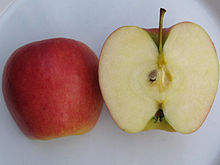Ambrosia (apple)
| Malus domestica 'Ambrosia' | |
|---|---|
 | |
| Cultivar | 'Ambrosia' |
| Origin | |
'Ambrosia' is a cultivar of apple originating in British Columbia, Canada in the early 1990s. The original tree was first cultivated by the Mennell family of Similkameen Valley, British Columbia, who discovered it growing in their orchard.[1]
Description
[edit]The fruit is medium to large, weighing about 215 grams (0.474 lb), and has mostly red, glossy colouration, with yellow patches. It has cream-coloured, firm meat with a sweet flavour reminiscent of pear and low acidity. 'Ambrosia' harvest is mid to late season. Trees are hardy and no major disadvantages have yet been identified.[2][3] These apples flower in mid to late season, and are in flower group 4.[clarification needed][4]
Ambrosia is most common in British Columbia, where it was discovered, and is the third most-produced apple in the province. It is also being produced in Ontario and Nova Scotia, as well as many other places around the world.[5]
Parentage
[edit]Parentage is suspected to be 'Starking Delicious' × 'Golden Delicious' because those apples existed in the orchard where the 'Ambrosia' was discovered growing.[6]
Patent
[edit]Ambrosia is a "club" variety of apple, in which a cultivar is patented by an organization that sets quality standards and provides marketing, while production is limited to club members.[7] The name was never trademarked, and the patent has expired in Canada and the United States.[8][9] Centralized control allowed limitation of color variation to pink/red, as the variety would color differently in warmer climates.[8][7][9] The patent expired in Canada in 2015, in the United States in 2017, and in Chile in 2021.[10] It remains active in many other countries until as late as 2034.[8] While under patent in Canada, the Mennells obtained plant breeders rights, and all growers were allowed, paying a royalty of C$2 per tree planting.[8] While under patent in the US, growers paid the lesser of US$1 per tree planting or US$1,000 per acre, and a US$1,000 franchise fee.[8]
See also
[edit]References
[edit]- ^ "Ambrosia®". Apples. Okanagan Plant Improvement Corporation (PICO). Retrieved 2012-01-15.
- ^ "The Ambrosia Apple Story: A Delicious, Home-Grown Original". bctree.com.
- ^ "Ambrosia Apple". British Columbia: Ministry of Agriculture. Retrieved 2012-01-15.
- ^ Ltd, Orange Pippin. "Apple - Ambrosia - tasting notes, identification, reviews". Orange Pippin - all about apples and orchards. Retrieved 2016-12-02.
- ^ "Ambrosia Apples in Canada - Frequently Asked Questions". Ambrosia Apples. Archived from the original on 2016-12-02. Retrieved 2016-12-02.
- ^ "Patent USPP10789 - Apple tree named 'Ambrosia'". google.com.
- ^ a b Brown, Susan; Maloney, K. E. (2009). "Making Sense of New Apple Varieties, Trademarks and Clubs: Current Status". New York Fruit Quarterly (17).
- ^ a b c d e Warner, Geraldine (2015-06-18). "Ambrosia Restrictions to End". Good Fruit Grower. Retrieved 2018-06-06.
- ^ a b Courtney, Ross (2017-06-07). "Ambrosia apple patent opens up: 20-year U.S. patent ends on popular club variety". Good Fruit Grower.
- ^ "Ambrosia apple patent will still be valid outside North America". Fresh Fruit Portal. 2017-06-09. Retrieved 2018-06-06.
